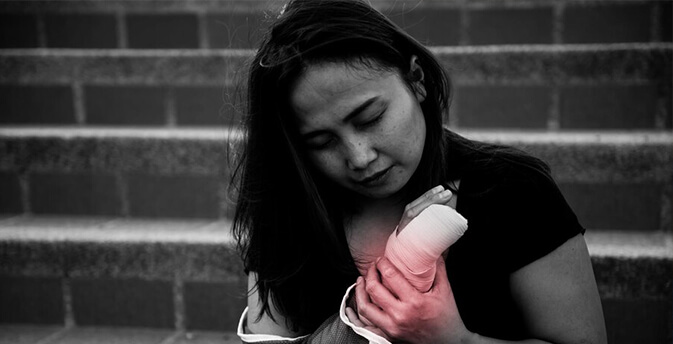Table Of Contents
The Devastating Physical, Emotional, And Financial Costs Of Burn Injuries
Injuries from burns can be among the most excruciating and life-altering experiences a person can endure. Whether from a kitchen mishap, a workplace accident, or a fire-related incident, the repercussions of burn injuries extend far beyond physical pain. They encompass emotional trauma and financial strain, reshaping lives in profound ways.
In this post, we’ll explore the multifaceted impact of burn injuries, examining the physical, emotional, and financial costs they entail. Through personal anecdotes and insightful analysis, we’ll shed light on the challenges faced by burn survivors and their families while offering valuable resources and support.
Physical Costs of Burn Injuries
The physical costs of burn injuries are profound and far-reaching, extending beyond the initial pain of the injury.

Burns can cause severe tissue damage, scarring, and loss of mobility. Even minor burns can lead to chronic pain and sensitivity, while more severe burns may necessitate extensive surgeries and ongoing medical care.
Additionally, the risk of infection is heightened, further complicating the recovery process. The physical toll of burn injuries is immense, often requiring long-term rehabilitation and medical intervention to manage the lasting effects.
Emotional Costs of Burn Injuries
Burn injuries not only affect the body but also take a significant toll on mental and emotional well-being.
Survivors often grapple with post-traumatic stress disorder (PTSD), experiencing vivid flashbacks and nightmares of the traumatic event.

Depression and anxiety are also common, stemming from the challenges of coping with pain, disfigurement, and changes in appearance.
Low self-esteem and body image issues may arise as survivors navigate the emotional impact of scars and physical alterations.
Social isolation and difficulty forming relationships can further compound the emotional burden, leading to feelings of loneliness and alienation.
The emotional costs of burn injuries are profound, requiring comprehensive support and intervention to address the psychological impact on survivors and their loved ones.
Financial Costs of Burn Injuries
Beyond the physical and emotional toll, burn injuries impose significant financial burdens on survivors and their families.
The cost of medical treatment, including surgeries, hospital stays, and rehabilitation, can quickly escalate into the tens or even hundreds of thousands of dollars.

Lost wages due to the inability to work during recovery further exacerbate financial strain, leaving survivors and their families struggling to make ends meet.
Additionally, modifications to homes and vehicles may be necessary to accommodate disabilities or mobility limitations caused by burn injuries.
Ongoing therapy and support services, such as counseling and specialized care, add to the long-term financial commitment.
Moreover, the financial impact extends to increased insurance premiums, as insurers perceive burn survivors as high-risk policyholders.
The cumulative financial costs of burn injuries underscore the importance of seeking compensation and financial assistance to mitigate the economic burden and secure a stable future. The treatment is quite expensive as well.
Burn injuries are quite costly to treat
Most of the time, burn injuries are extremely expensive to treat, as a serious injury could be responsible for causing multiple problems. Physical injuries that are caused by burn injuries are:
- Skin loss, skin damage, disfigurement and scarring
- Contracture (the skin becomes tight and limits mobility)
- Bone damage (along with severe burn injuries)
- Soft tissues like muscles, ligaments, and tendons are also damaged
- Nerve damage
- Lung damage
- Loss of vision
- Sometimes, other internal organs are also damaged, causing medical complications
Hospital stays are also required in case of severe burn injuries, and these take a long time to recover and need much longer stays than any other non-burn injuries. The cost of treating burn injuries is a lot higher than any non-burn injuries.
It is often twice the amount required to treat any non-burn injuries. According to the American Burn Association, any burn accident patient with 40 to 60% of their body burned needs to be in hospital for about an average of 54 days. On an average, it costs around $780,000.
If the burns are even more serious, the cost can be sky-high. When the burns are severe but there are not many complications, the cost can be around $1.6 million on average.
How do complications increase the cost of treatment?
Given that complications increase the medical cost the most, here is how it can go.
- Burn injuries are more susceptible to infections, and that can add up to $120,000. And this is actually the case in almost 35% of the cases.
- Slow healing and skin grafts are known to increase the cots as well. It can go upto $110,000. This is the case in almost 32% of the cases.
- Skin breakdown and fragile skin also increase the cost to almost $107,000. And this happens in almost 55% of the cases.
- PTSD and any other psychological issues add almost $75,000 to the original hospital costs, and this is something that happens in almost 57% of the cases.
- Coontracture, scarring, and disfigurement increase the cost by $35,000, and this is seen in almost 66% of the cases.
Serious burn injuries often need a multitude of specialists. They can need:
- Anesthesiologists
- Wound-care professionals
- Pain management specialists
- Social workers and mental health professionals
- Surgeons, including reconstructive surgeons and plastic surgeons
- Different types of therapists, including occupational, speech, physical, and otters, depending on the type of injury.
This kind of specialized care is quite expensive. On top of that, there are different medications, pain relief, antibiotics are the bare minimum that is needed, and these are also costly. Along with that, specialized wound dressings, bandages to limit scarring, and blood transfusions are also available.
After returning from the hospital, if there is a need to modify the house or the vehicle to help with the new disability, the cost even increases. Some of the other items that add to the cost are orthotics, prosthetics, walkers, and wheelchairs. Specialed home care is also required often, which increases the cost.
Seeking Support and Resources
For individuals and families grappling with the aftermath of burn injuries, accessing support and resources is crucial for navigating the challenges ahead.
Fortunately, numerous organizations and programs exist to provide assistance and guidance during this difficult time. Support groups offer a sense of community and understanding, allowing individuals to connect with others who have shared similar experiences.

Additionally, financial assistance programs can help alleviate the burden of medical expenses and ongoing care.
Legal resources and advocacy groups are also available to provide guidance on legal options and advocate for the rights of burn survivors.
By exploring these resources and reaching out for support, individuals can find strength, resilience, and a path forward toward healing and recovery.
Amidst the Challenges, There is Resilience
In conclusion, the physical, emotional, and financial toll of burn injuries cannot be overstated.
From the immediate pain and long-term physical consequences to the psychological impact and financial burdens, burn injuries affect every aspect of a person’s life. However, amidst the challenges, there is also resilience, hope, and the potential for healing.
By shedding light on the devastating impact of burn injuries and sharing real-life stories, we aim to raise awareness and encourage support for those affected. It’s essential to recognize the strength and courage of burn survivors and their families, as well as to advocate for better resources and support systems.
As we move forward, let us continue to offer compassion, understanding, and assistance to those affected by burn injuries. Together, we can make a difference in the lives of burn survivors and work towards a future where everyone has access to the support they need to thrive.
MORE FOR YOU:











Leave A Comment